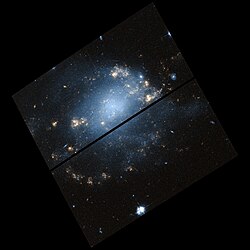| NGC 428 | |
|---|---|
 Hubble image of NGC 428. | |
| Observation data (J2000.0 epoch) | |
| Constellation | Cetus [1] |
| Right ascension | 01h 12m 55,709s [2] |
| Declination | +00° 58′ 53.69″ [2] |
| Distance | 48 mly [3] |
| Apparent magnitude (B) | 12.1 [2] |
| Characteristics | |
| Type | SAB(s)m [4] |
| Other designations | |
| NGC 428 • UGC 763 • PGC 4367 • Z 385.28 • MCG + 00-04-36 • IRAS 01103 + 0043 • 2MASX J01125570 + 0058536 • GC 238 • H 2.622 • HIPASS J0112 + 00 [2] | |
NGC 428 is a barred spiral galaxy in the constellation of Cetus (The Sea Monster), with its spiral structure distorted and warped, possibly the result of the collision of two galaxies. [3] There appears to be a substantial amount of star formation occurring within NGC 428 and it lacks well defined arms — a telltale sign of a galaxy merger. [3] In 2015 the Hubble Space Telescope made a close-up shot of the galaxy with its Advanced Camera for Surveys and its Wide Field and Planetary Camera 2. [1] The structure of NGC 428 has been compared to NGC 5645. [4]
